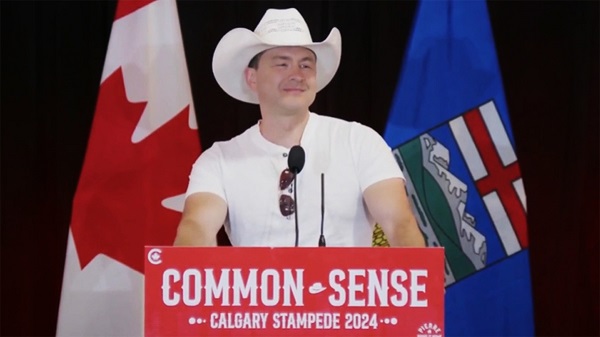Business
Spending restraint: Roadmap to a balanced budget

From the Fraser Institute
A Case for Spending Restraint: How the Federal Government Can Balance the Budget
By Grady Munro and Jake Fuss
Since 2015, there has been a deterioration in the federal government’s fiscal situation. Annual
nominal program spending has increased an estimated $193.6 billion since 2014/15; adjusted for
inflation and population growth this represents an extra $2,330 per person. Prior to the COVID
pandemic, spending increased faster than population, inflation, and other relevant economic
indicators. These spending increases have resulted in a string of large budgetary deficits that have
contributed to an estimated $941.9 billion increase in gross federal debt from 2014/15 to 2023/24.
This accumulation of debt, along with recent hikes in interest rates, has raised the cost of interest
on the federal debt to one of the largest budget expense items.
Moving forward, the federal government plans to slow nominal spending growth, which will keep inflation-adjusted, per-person spending relatively constant to 2026/27. Despite this, the federal government will continue running budget deficits and accumulating debt. It is also uncertain whether the federal government’s current estimates are truly reliable as the estimates do not incorporate expected spending on pharmacare or the level of defence spending to meet Canada’s NATO commitment. Moreover, the federal government’s track record of exceeding previous spending commitments calls into question the reliability of the current spending targets. Therefore, it is clear the federal government is not implementing the level of spending restraint necessary to reverse course towards a stable fiscal situation.
An approach to federal finances that continues to run budget deficits and accumulate debt is economically harmful to both current and future generations of Canadians. Research shows that significant increases in debt-financed spending harm economic growth by reducing capital accumulation and labour productivity.
Furthermore, accumulating debt today increases the tax burden on future generations of Canadians, as they will be responsible for paying off this debt. Despite these effects, the federal government plans to continue running deficits and accumulating debt for the foreseeable future.
This need not be the case. The federal government can undertake decisive spending reform starting in 2024— similar to the reform by the Chrétien government in the 1990s—that balances the budget within a year or two. The federal government could balance the budget in 2026/27 by limiting annual growth in nominal program spending to 0.3% for two years. This would result in a 5.9% reduction in real per-person spending. Alternatively, the budget could be balanced in 2025/26 if the federal government reduces spending 4.3% for one year; the next year, 2026/27, would see a budgetary surplus. In this scenario, inflation-adjusted per-person spending would decline by 7.5%. Key trade-offs between the two approaches include the extent of the spending reform and the speed of the return to balanced budgets. Balancing the budget in one year, as opposed to two years, would
result in $30.0 billion less debt accumulated by 2026/27.
Though it is beyond the scope of this study to discuss how such spending reforms should be implemented, there are three areas that might be considered for reform. Business subsidies are a significant expense, yet research suggests they have little if any economic benefit, and may actually harm economic growth when governments pick winners and losers in a free market. Reviewing business subsidies might provide opportunities to find savings. Aligning government-sector wages
with those in the private sector would also provide savings, as government workers in Canada currently enjoy an 8.5% wage premium (on average) relative to comparable private-sector workers. Finally, studies show that government fiscal waste can be significant. From 1988 to 2013, more than 600 government failures cost the federal government between $158.3 billion and $197.1 billion. Moreover, more than 25% of all federal COVID spending was wasteful. Addressing inefficiencies within government might also reveal savings.

- Canada has seen a deterioration in the federal government’s fiscal situation since 2015. A distinct lack of spending restraint has resulted in a string of large budget deficits, which have contributed to rising government debt and debt interest costs.
- Despite current fiscal plans promising more of the same, the federal government could implement decisive spending reform starting in 2024/25, similar to reforms implemented in the 1990s, and balance the budget within one or two years.
- To balance the budget by 2026/27, the federal government would need to limit growth in annual nominal program spending to 0.3 percent for two years. This would translate to a 5.9 percent reduction in inflation-adjusted, per-person spending.
- Alternatively, the federal government could balance the budget in one year, by 2025/26, by reducing nominal program spending by 4.3 percent. Adjusted for inflation and population, this would be a 7.5 percent decrease. In 2026/27, the federal government could then record a $8.2 billion surplus even while increasing spending from the previous year.
- While this study does not provide an in-depth analysis of where potential savings should be found, research highlights three potential areas that could be targeted for spending reform: corporate welfare, aligning government-sector wages with those in the private sector, or eliminating government fiscal waste.
A Case for Spending Restraint in Canada: How the Federal Government Can Balance the Budget
Authors:
Automotive
Federal government should swiftly axe foolish EV mandate

From the Fraser Institute
Two recent events exemplify the fundamental irrationality that is Canada’s electric vehicle (EV) policy.
First, the Carney government re-committed to Justin Trudeau’s EV transition mandate that by 2035 all (that’s 100 per cent) of new car sales in Canada consist of “zero emission vehicles” including battery EVs, plug-in hybrid EVs and fuel-cell powered vehicles (which are virtually non-existent in today’s market). This policy has been a foolish idea since inception. The mass of car-buyers in Canada showed little desire to buy them in 2022, when the government announced the plan, and they still don’t want them.
Second, President Trump’s “Big Beautiful” budget bill has slashed taxpayer subsidies for buying new and used EVs, ended federal support for EV charging stations, and limited the ability of states to use fuel standards to force EVs onto the sales lot. Of course, Canada should not craft policy to simply match U.S. policy, but in light of policy changes south of the border Canadian policymakers would be wise to give their own EV policies a rethink.
And in this case, a rethink—that is, scrapping Ottawa’s mandate—would only benefit most Canadians. Indeed, most Canadians disapprove of the mandate; most do not want to buy EVs; most can’t afford to buy EVs (which are more expensive than traditional internal combustion vehicles and more expensive to insure and repair); and if they do manage to swing the cost of an EV, most will likely find it difficult to find public charging stations.
Also, consider this. Globally, the mining sector likely lacks the ability to keep up with the supply of metals needed to produce EVs and satisfy government mandates like we have in Canada, potentially further driving up production costs and ultimately sticker prices.
Finally, if you’re worried about losing the climate and environmental benefits of an EV transition, you should, well, not worry that much. The benefits of vehicle electrification for climate/environmental risk reduction have been oversold. In some circumstances EVs can help reduce GHG emissions—in others, they can make them worse. It depends on the fuel used to generate electricity used to charge them. And EVs have environmental negatives of their own—their fancy tires cause a lot of fine particulate pollution, one of the more harmful types of air pollution that can affect our health. And when they burst into flames (which they do with disturbing regularity) they spew toxic metals and plastics into the air with abandon.
So, to sum up in point form. Prime Minister Carney’s government has re-upped its commitment to the Trudeau-era 2035 EV mandate even while Canadians have shown for years that most don’t want to buy them. EVs don’t provide meaningful environmental benefits. They represent the worst of public policy (picking winning or losing technologies in mass markets). They are unjust (tax-robbing people who can’t afford them to subsidize those who can). And taxpayer-funded “investments” in EVs and EV-battery technology will likely be wasted in light of the diminishing U.S. market for Canadian EV tech.
If ever there was a policy so justifiably axed on its failed merits, it’s Ottawa’s EV mandate. Hopefully, the pragmatists we’ve heard much about since Carney’s election victory will acknowledge EV reality.
Business
Prime minister can make good on campaign promise by reforming Canada Health Act

From the Fraser Institute
While running for the job of leading the country, Prime Minister Carney promised to defend the Canada Health Act (CHA) and build a health-care system Canadians can be proud of. Unfortunately, to have any hope of accomplishing the latter promise, he must break the former and reform the CHA.
As long as Ottawa upholds and maintains the CHA in its current form, Canadians will not have a timely, accessible and high-quality universal health-care system they can be proud of.
Consider for a moment the remarkably poor state of health care in Canada today. According to international comparisons of universal health-care systems, Canadians endure some of the lowest access to physicians, medical technologies and hospital beds in the developed world, and wait in queues for health care that routinely rank among the longest in the developed world. This is all happening despite Canadians paying for one of the developed world’s most expensive universal-access health-care systems.
None of this is new. Canada’s poor ranking in the availability of services—despite high spending—reaches back at least two decades. And wait times for health care have nearly tripled since the early 1990s. Back then, in 1993, Canadians could expect to wait 9.3 weeks for medical treatment after GP referral compared to 30 weeks in 2024.
But fortunately, we can find the solutions to our health-care woes in other countries such as Germany, Switzerland, the Netherlands and Australia, which all provide more timely access to quality universal care. Every one of these countries requires patient cost-sharing for physician and hospital services, and allows private competition in the delivery of universally accessible services with money following patients to hospitals and surgical clinics. And all these countries allow private purchases of health care, as this reduces the burden on the publicly-funded system and creates a valuable pressure valve for it.
And this brings us back to the CHA, which contains the federal government’s requirements for provincial policymaking. To receive their full federal cash transfers for health care from Ottawa (totalling nearly $55 billion in 2025/26) provinces must abide by CHA rules and regulations.
And therein lies the rub—the CHA expressly disallows requiring patients to share the cost of treatment while the CHA’s often vaguely defined terms and conditions have been used by federal governments to discourage a larger role for the private sector in the delivery of health-care services.
Clearly, it’s time for Ottawa’s approach to reflect a more contemporary understanding of how to structure a truly world-class universal health-care system.
Prime Minister Carney can begin by learning from the federal government’s own welfare reforms in the 1990s, which reduced federal transfers and allowed provinces more flexibility with policymaking. The resulting period of provincial policy innovation reduced welfare dependency and government spending on social assistance (i.e. savings for taxpayers). When Ottawa stepped back and allowed the provinces to vary policy to their unique circumstances, Canadians got improved outcomes for fewer dollars.
We need that same approach for health care today, and it begins with the federal government reforming the CHA to expressly allow provinces the ability to explore alternate policy approaches, while maintaining the foundational principles of universality.
Next, the Carney government should either hold cash transfers for health care constant (in nominal terms), reduce them or eliminate them entirely with a concordant reduction in federal taxes. By reducing (or eliminating) the pool of cash tied to the strings of the CHA, provinces would have greater freedom to pursue reform policies they consider to be in the best interests of their residents without federal intervention.
After more than four decades of effectively mandating failing health policy, it’s high time to remove ambiguity and minimize uncertainty—and the potential for politically motivated interpretations—in the CHA. If Prime Minister Carney wants Canadians to finally have a world-class health-care system then can be proud of, he should allow the provinces to choose their own set of universal health-care policies. The first step is to fix, rather than defend, the 40-year-old legislation holding the provinces back.
-

 MAiD2 days ago
MAiD2 days agoCanada’s euthanasia regime is already killing the disabled. It’s about to get worse
-

 Daily Caller14 hours ago
Daily Caller14 hours agoUSAID Quietly Sent Thousands Of Viruses To Chinese Military-Linked Biolab
-

 Alberta11 hours ago
Alberta11 hours ago‘Far too serious for such uninformed, careless journalism’: Complaint filed against Globe and Mail article challenging Alberta’s gender surgery law
-

 Censorship Industrial Complex22 hours ago
Censorship Industrial Complex22 hours agoCanadian pro-freedom group sounds alarm over Liberal plans to revive internet censorship bill
-

 Fraser Institute1 day ago
Fraser Institute1 day agoBefore Trudeau average annual immigration was 617,800. Under Trudeau number skyrocketted to 1.4 million from 2016 to 2024
-

 Daily Caller2 days ago
Daily Caller2 days ago‘I Know How These People Operate’: Fmr CIA Officer Calls BS On FBI’s New Epstein Intel
-

 International2 days ago
International2 days agoChicago suburb purchases childhood home of Pope Leo XIV
-

 Economy1 day ago
Economy1 day agoThe stars are aligning for a new pipeline to the West Coast




